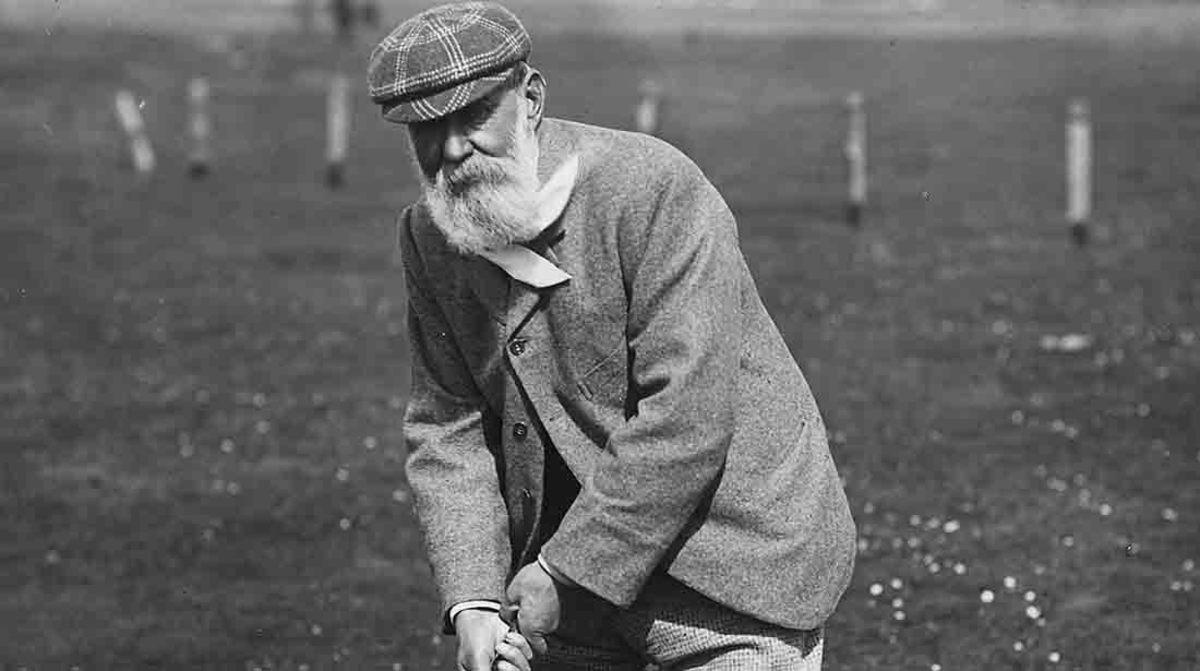This Celebrated 150th British Open Is Also a Tip Of the Cap To Old Tom Morris

ST. ANDREWS, Scotland – The Old Tom Morris Golf Shop so easily seen from the 18th hole of the Old Course no longer exists – at least not in name – ingloriously replaced by a store front that says “The Open" in an ode to modern times.
It is somewhat ironic in the context of the celebration this week of the 150th British Open and links to the past, which could hardly be discussed without a lengthy mention of Morris, the longtime “keeper of the green’’ who won The Open four times and cared for the Old Course almost until his death in 1908.
Morris was an innovator who was also a top-level player, golf ball maker, greenskeeper and designer. He was a key part of the game’s growth well over a century ago, and had a big role in the maturation of the Old Course, which hosts the game’s oldest championship for the 30th time this week.
“Tom was known in his own lifetime as “The Grand Old Man of Golf’’ and for good reason,’’ said Roger McStravick, a St. Andrews-based golf historian and author. “He simply touched upon and knew more about every element of the game than any other.
“From starting out as a boy caddie, in later life he set to improve their professionalism and welfare. He became a professional golfer, the best in the world, winning The Open four times, oldest winner and largest margin of victory, 13 shots in 1862.

“In later life, he designed or modified over 100 courses. His methods for course maintenance, such as topdressing or tin cups (debatable but Tom believed he invented it), are still in use today. I would like to think that it was as a designer where he excelled.’’
Morris remains the oldest winner of The Open and held the record for widest margin of victory in any major championship, 13 shots, until Tiger Woods won the U.S. Open in 2000 by 15 strokes – a record that went unchallenged for 138 years.
Although Morris did not win any of his Opens at the Old Course – the first 12 championships were played at Prestwick, where Morris also worked as a greenskeeper – he became associated with it due to his diligence in nurturing the course over the years.
The “Home of Golf’’ is considered the game’s birthplace, more than 500 years ago. It is where 22 original holes were built, later scaled back to what is now the regulation 18 in 1764.
And it is where Morris spent most of his life.
“He was down on the links as soon as he could walk and caddied as a young boy,’’ McStravick said. “Madras school opened up when he was around 12, but Tom had little schooling. The course he knew was evolving thanks to Sir Hugh Lyon Playfair, who returned to St. Andrews in the early 1830s and set about the revolution of St. Andrews town and links.
“Tom would have known the links before the land reclamation that created the flat ground for the first hole. That would have been beach as Tom grew up. The back nine today would have been the entire course width then, playing back and forth to the same greens. So the first hole would have been roughly from the 18th green to 17th green. There is no first green. Tom created that in early 1870s.’’
Well before Morris took on the task of molding the Old Course (it didn’t go by that name until 1895, when the adjoining “New’’ Course was opened), Morris formed a partnership with Allan Robertson, perhaps the first great golfer and the first to break 80 at St. Andrews.
Robertson had a golf ball manufacturing business. At the time, the ball – called a “feathery’’ – was a laborious process to make. The outer surface was leather stuffed with feathers which expanded the leather, eventually shrinking into a tight, firm ball.
According to St. Andrews historian David Joy, perhaps two to four such balls could be made in a day. But golf became more popular anyway, and with that came a group of serious players who barnstormed around Scotland playing exhibition matches that were loaded with gambling elements.
Robertson and Morris often teamed up in such matches, but their relationship became strained when Morris learned of a new way golf balls could be made – with gum that came from trees made in Malaysia. This substance was more durable – a feathery often became difficult to play in wet conditions – and perhaps more important, far more affordable – about half the price of a “feathery.’’
“Nothing was more dramatic than the move from the feather ball to the gutta ball,’’ Joy said.
“I think the difference between Tom’s reaction and Allan Robertson’s is that Tom welcomed it,’’ McStravick said. “Allan was running a company that since the late 1500s were feathery ball makers (and shoes).
“Allan saw this change as the death knell to his heritage and was very defensive. Tom did not have that long history, although a history of caddying and good golf. This welcoming of the future is a pattern that runs through Tom’s life from ladies golf, to topdressing links to setting standards for caddies. That is probably the greatest aspect of Tom Morris.’’
In the early 1850s, out of work due to his split with Robertson, Morris made the move to the west of Scotland while Robertson continued to excel at the game. (Robertson contracted jaundice late in the decade and died at age 45 in 1859).
Morris took on the task of “keeper of the green’’ at the Prestwick course, a 12-hole layout that would become home to the first Open in 1860. It would host 12 in succession and 24 overall, the last played there in 1925.
He was a surprise runner-up to Willie Park at the first Open, finishing two shots back over 36 holes – played in 12-hole rounds. But he won three of the next four and again in 1867 – at the age of 46, still making him the oldest winner of the tournament.
A year later, he finished second to his son, Tom Jr. (known as Young Tom Morris), who would go on to win four in a row.
Tom Jr. was the young star of the day, what we could call a phenom who excelled as a teenager. He was just 24 when he died in 1874 soon after the death of his wife and son during childbirth. Young Tom died of what was called an aneurysm, although many reported through the years it was of “a broken heart.’’
Meanwhile, Old Tom continued to play in The Open, a total of 34 times, through 1896 – at age 74. Seven of those Opens were played at the Old Course, where he lived nearby.
Morris was so instrumental in so many aspects of the game. He helped devise the first metal cups for firming up the hole; he learned how sand, scattered over bare spots, helped grass grow; he designed or laid out courses across the British Isles (the going rate was one pound per day, plus expenses). Among them were Muirfield, Royal Dornoch, Lahinch and Royal County Down in Northern Ireland.
As for his game, Morris was known for his course management and accuracy from tee to green. Short putts were a problem, making him possibly the inventor of the yips as well.
“He was there just at the right time,’’ said Joy, who authored the book "St. Andrews & The Open Championship." “You’re talking about a lifespan that ranged from starting your career as a feather golf ball maker, through the gutta percha ball, to seeing trains linked from the linksland to the seaside courses, to play in the first Opens, to winning it, to be the custodian of the links for nearly 40 years.
“He was involved in the major changes that occurred during the evolution of the game. It’s unusual for a man to live to 86 at that time. He lived through some stunning changes.’’

At his golf shop, Morris made or sold clubs from 1865 until his retirement in 1904. He lived upstairs in a flat that is still used by his descendants.
It later became a tradition that Old Tom would be the starter for all the Royal & Ancient meetings and matches, then tend the pin on the final hole for selected matches. And, of course, he was a prolific designer of courses.
“He was involved in every course you can think of that was a major course,’’ Joy said. “He changed Carnoustie to 18 holes in 1866. He had a hand in Muirfield and so many others. And he never raised his price in 50 years – one pound a day plus expenses. That was his way of giving back.
“And in all the research I did about him, I couldn’t find a bad word about him. He was a caddie’s friend as well as a gentlemen’s friend.’’
The Open will be played for the 30th time in St. Andrews and Morris would undoubtedly be proud. While the Old Tom Morris Golf Shop no longer exists in name, the Old Course is still virtually the same layout as was present for the first Open here in 1873, with yardage added to better suit today’s players.
While there has long been fear that the modern generation would overrun the old links, it has yet to happen. Hence the course and the man who made it into what it was and is remain such integral parts of the game.
